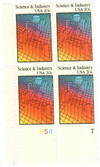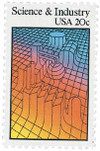
# 2031 - 1983 20c Science and Industry
U.S. #2031
1983 20¢ Science and Industry
- Honors the teamwork of science and industry
- Coincides with the 50th anniversary of Chicago’s Museum of Science and Industry
Stamp Category: Commemorative
Value: 20¢, first-class rate
First Day of Issue: January 19, 1983
First Day City: Chicago, Illinois
Quantity Issued: 118,555,000
Printed by: Bureau of Engraving and Printing
Printing Method: Lithographed & engraved
Format: Panes of 50 in sheets of 200
Perforations: 11
Why the stamp was issued: When the stamp was announced a month and a half earlier on December 1, 1982, the USPS said it would honor the teamwork of science and industry, stating “Working together, they have produced such important developments as electrical power, the automobile, radio and television, synthetic fibers, electronics, jet air travel, computers, lasers, nuclear energy, antibiotics, and space exploration.” The stamp’s issue also coincided with the 50th anniversary of Chicago’s Science and Industry Museum, though the USPS didn’t officially say the stamp commemorated the event.
About the stamp design: Saul Bass designed this stamp using abstract depictions to represent science and industry. Bass created a series of tube, square, and globular forms representing industry set against a computer-like grid. The combination is meant to portray a three-dimensional view of the high-tech industrial complex.
About the printing process: The Bureau of Engraving and Printing had issues printing the blended background and black intaglio of this stamp. They had on-going registration issues and had to change the printing plates frequently. This resulted in a large number of plate number combinations. The print quantity was also lower than expected due to these printing issues.
First Day City: The First Day ceremony for this stamp was held at the Chicago Museum of Science and Industry.
Unusual fact about this stamp: This stamp has been found with black engraving omitted or shifted. There are also some misperforated freaks.
History the stamp represents: In 1893, the Palace of Fine Arts, designed by Charles B. Atwood, opened at the World’s Columbian Exposition in Chicago. Visitors to the fair could see all forms of artwork from around the world within the palace. Following the exposition, the palace, was home to the Columbian Museum, showing items left from the fair. For a time, the building served as the Field Museum of Natural History. After a brief campaign to turn it into an art museum, it was decided to make it a science museum, with significant funding provided by Julius Rosenwald, president of Sears, Roebuck, and Company. The Museum of Science and Industry opened during the 1933 Century of Progress Exposition and was later declared a Chicago landmark.
U.S. #2031
1983 20¢ Science and Industry
- Honors the teamwork of science and industry
- Coincides with the 50th anniversary of Chicago’s Museum of Science and Industry
Stamp Category: Commemorative
Value: 20¢, first-class rate
First Day of Issue: January 19, 1983
First Day City: Chicago, Illinois
Quantity Issued: 118,555,000
Printed by: Bureau of Engraving and Printing
Printing Method: Lithographed & engraved
Format: Panes of 50 in sheets of 200
Perforations: 11
Why the stamp was issued: When the stamp was announced a month and a half earlier on December 1, 1982, the USPS said it would honor the teamwork of science and industry, stating “Working together, they have produced such important developments as electrical power, the automobile, radio and television, synthetic fibers, electronics, jet air travel, computers, lasers, nuclear energy, antibiotics, and space exploration.” The stamp’s issue also coincided with the 50th anniversary of Chicago’s Science and Industry Museum, though the USPS didn’t officially say the stamp commemorated the event.
About the stamp design: Saul Bass designed this stamp using abstract depictions to represent science and industry. Bass created a series of tube, square, and globular forms representing industry set against a computer-like grid. The combination is meant to portray a three-dimensional view of the high-tech industrial complex.
About the printing process: The Bureau of Engraving and Printing had issues printing the blended background and black intaglio of this stamp. They had on-going registration issues and had to change the printing plates frequently. This resulted in a large number of plate number combinations. The print quantity was also lower than expected due to these printing issues.
First Day City: The First Day ceremony for this stamp was held at the Chicago Museum of Science and Industry.
Unusual fact about this stamp: This stamp has been found with black engraving omitted or shifted. There are also some misperforated freaks.
History the stamp represents: In 1893, the Palace of Fine Arts, designed by Charles B. Atwood, opened at the World’s Columbian Exposition in Chicago. Visitors to the fair could see all forms of artwork from around the world within the palace. Following the exposition, the palace, was home to the Columbian Museum, showing items left from the fair. For a time, the building served as the Field Museum of Natural History. After a brief campaign to turn it into an art museum, it was decided to make it a science museum, with significant funding provided by Julius Rosenwald, president of Sears, Roebuck, and Company. The Museum of Science and Industry opened during the 1933 Century of Progress Exposition and was later declared a Chicago landmark.










